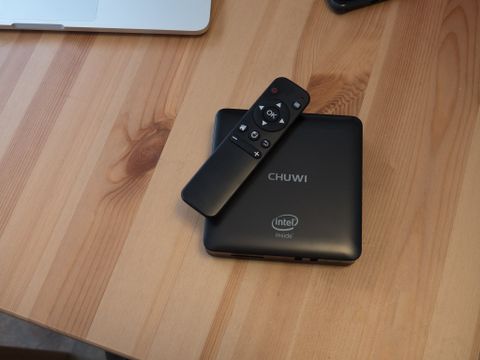A quality dual-boot system has forever been the holy grail of nerds. We've got it in Windows-Linux configurations, sort of have it in a "Hackintosh," and fake it in macOS with Boot Camp or Parallels. (That's not meant to be disparaging, it's just different.)
Thanks to the flexibility of Android, we can cram the world's most prevalent "mobile" OS alongside the world's most popular desktop OS. Enter the Chuwi HiBox Mini PC, an unholy marriage of a current iteration of Windows and an outdated and largely unusable iteration of Android.
Chuwi HiBox Mini PC technical specifications
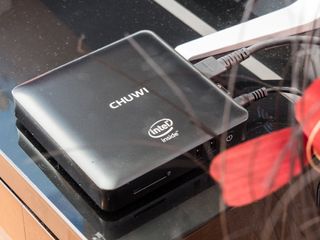
| Category | Specs |
|---|---|
| Form factor | Mini PC box |
| OS | Windows 10 Home and Android 5.1 dual-boot |
| CPU | Intel X5 Z8350 |
| Storage | 64GB (less available to user) |
| RAM | 4GB |
| Network | 802.11 b/g/n, Ethernet |
| Price | $150 to $200 depending on retailer |
| Target user | Someone who wants new Windows and old Android in one place. |


What's good
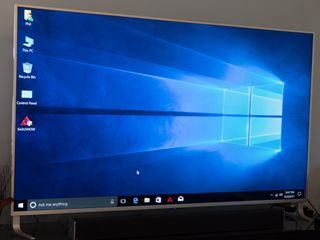
Setting up the HiBox is super simple. You just plug in power (mine came with a Euro plug, so you might well need an adapter), plug in a display (I'm using HDMI) and a keyboard (Bluetooth works great) and boot it up. The box is about the size of a couple decks of cards, but a little thicker.
You're quickly greeted by a graphical option for either Windows or Android. By default, it'll kick into the former. That's a good thing, as the latter is a shitshow.
Log into Windows and ... you're in Windows and can do all the Windows things you like. This isn't the most powerful box in the world, and it's extremely limited on storage, with about 30GB of an available 43GB left over for use. (It'll take an SD card, though, and it's got two more USB ports on the side, for a total of three.) And 4GB of RAM doesn't leave a lot (or any) overhead for anything too intensive.
Want to browse some web pages? Run a couple apps? Go for it. Just, ya know, take it easy.
The box also comes with mounting hardware should you want to stick it somewhere out of sight, a nice touch.
See the full specs at Chuwi{.cta .large}
What's not good
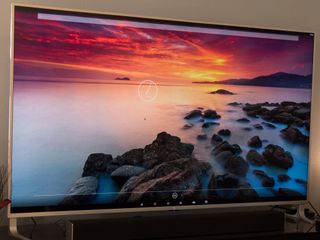
If there's a microphone in this box (Chuwi says it's "supported"), I couldn't get it to work with Cortana.
If you don't boot straight into Android, there's a "SwitchNow" link on the Windows desktop that'll point you to the dark side.
Once you're booted up into Android (this takes a couple minutes), you're greeted with a spartan desktop and an anemic app drawer. Chuwi doesn't hide the fact that you're inside Android 5.1 — but that doesn't make knowing you're using a dead version of the OS any easier. (Only about a quarter of all active Android users are still on 5.0 "Lollipop," and for good reason.)
The Android experience is even slower than Windows and certainly isn't helped by the fact that the OS is not designed to be a good desktop UI. There's about 10GB of storage allocated to the Android side of things, with about 9GB available after first boot.
I was surprised to find Google's services preloaded, including Google Play. But none of Google's staple apps are included — no Gmail or Chrome— and the Google Play Store seems broken, unable to show me the apps that are installed or whether anything needs to be updated.
The HiBox comes with a AA-powered remote control (BYOBatteries) if you don't have a real keyboard and mouse. The remote serves as a bad wave-in-the-air pointer thing, so you can look like an idiot while badly controlling things in Windows or Android
Chuwi HiBox mini PC review bottom line
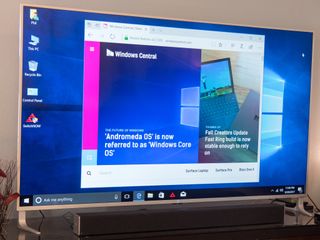
Why would you want this box? I have no idea. There are better Windows experiences that come with more hardware, though at a higher price. You get what you pay for, of course. If you just need something extremely basic on the Windows side that won't require too much power, the HiBox will fit the bill.
Buy it for Windows if you must, but don't buy it for Android.
There's absolutely no reason to buy this box because it dual-boots to Android, though. It's a bad Android experience and just a bad tech experience. It's like it was bolted on just to say it dual-boots to Android, experience be damned.
So buy it for Windows. Buy it for a half-decent desktop (or even TV-sized) Windows experience for not a whole lot of money. Just don't expect too much. It's far from powerful, doesn't have much storage out of the box, and you'll still need to bring along your own mouse and keyboard.
Most definitely don't expect anything from the Android side of the monster.
The good:
- Easy setup.
- Small footprint.
- Easy to switch from Windows to Android.
The bad:
- Android 5.1 is ancient and bad and shouldn't be used on desktop.
Phil is the father of two beautiful girls and is the Dad behind Modern Dad. Before that he spent seven years at the helm of Android Central. Before that he spent a decade in a newsroom of a two-time Pulitzer Prize-finalist newspaper. Before that — well, we don't talk much about those days. Subscribe to the Modern Dad newsletter!
